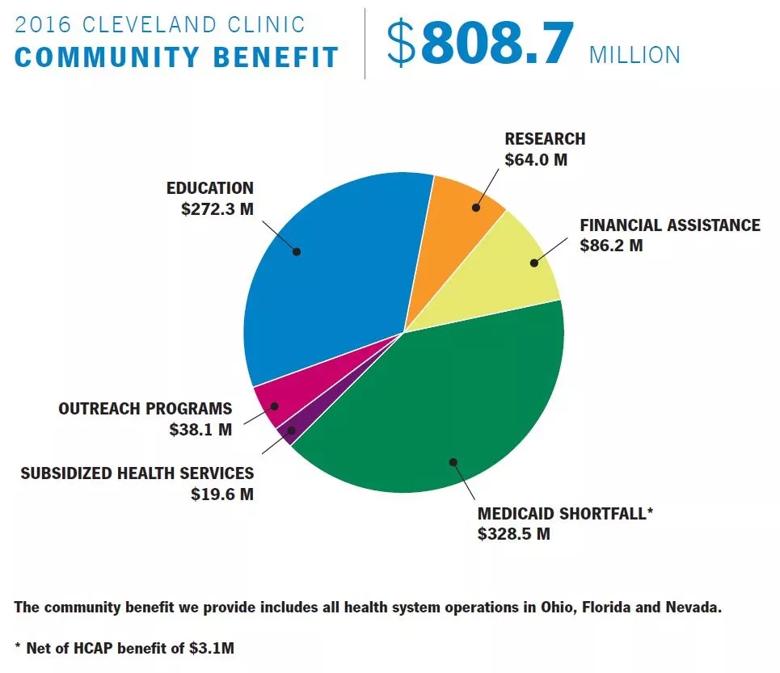Figure includes outreach programs, medical education, research, subsidized care
Cleveland Clinic News Service | 216.444.0141
We’re available to shoot custom interviews & b-roll for media outlets upon request.
CCNS health and medical content is consumer-friendly, professional broadcast quality (available in HD), and available to media outlets each day.
images: 0
video: 0
audio: 0
text: 0

In 2016 Cleveland Clinic provided $809 million in community benefit in Ohio, Nevada and Florida, a 17 percent increase over 2015.

Community benefit is a measure of a hospital’s investment in its community through outreach programs, medical education, research, financial assistance, coverage of Medicaid shortfalls, and subsidized care.
“As a non-profit academic medical center, we are a community asset with no owners, investors or stockholders,” said Toby Cosgrove, M.D., President and CEO of Cleveland Clinic. “Any and all operating surplus is invested back into the health system to support new research and education initiatives and to cultivate a healthier population by promoting access to healthcare and encouraging healthy behaviors and lifestyles in our communities.”
Cleveland Clinic calculates community benefit conforming to the IRS Form 990 guidelines. Community benefit includes activities or programs that improve access to health services, enhance public health, advance generalizable knowledge and relieve government burden. Cleveland Clinic’s 2016 totals marked the highest level of community benefit in its reporting history.
“Cleveland Clinic is committed to meeting the health and wellness needs of the populations we serve,” said Steve Glass, Cleveland Clinic’s Chief Financial Officer. “Our community benefit efforts support our founding principles: better care of the sick, educating the next generation of healthcare professionals, and funding medical research that leads to advanced treatments and cures.”
The primary categories for assessing community benefit include financial assistance, Medicaid shortfall, subsidized health services, outreach programs, education and research:
Financial assistance is the amount of free or discounted medically necessary care provided to those patients unable to pay some or all of their bills. Cleveland Clinic’s financial assistance policy provides free or discounted care to patients with incomes up to 400 percent of the federal poverty level and covers both hospital care and our employed physician services.
The Medicaid program, which provides healthcare coverage for low-income families and individuals, is funded by state and federal governments. In many states, including Ohio, Medicaid payments have not been sufficient to cover the costs of treating Medicaid beneficiaries. In 2016, Cleveland Clinic experienced a 35 percent increase in Medicaid shortfall compared to 2015.
Subsidized health services are clinical services provided to meet the needs of the community despite creating a financial loss. Subsidized health services within Cleveland Clinic include pediatric programs, psychiatric/behavioral health programs, obstetrics services, chronic disease management and outpatient clinics.
Cleveland Clinic’s outreach programs are designed to serve the most vulnerable and at-risk populations as identified in our comprehensive Community Health Needs Assessments.
Programs range from free wellness initiatives, health screenings, clinical services and education to enrollment assistance for government-funded health programs.
In 2016, highlights included:
Cleveland Clinic takes pride in a wide range of high-quality medical education that includes accredited training programs for residents, physicians, nurses and allied health professionals. By educating medical professionals, we ensure that the public is receiving the highest standard of medical care and will have highly trained health professionals to care for them in the future.
Research into diseases and their cures is an investment in people’s long-term health. From a community benefit standpoint, research includes basic, clinical and community health research, as well as studies on healthcare delivery. Cleveland Clinic’s Lerner Research Institute is continually bringing medical advances into patient care and to the medical world through the development of new techniques, devices and treatment protocols. Over 1,900 scientists and support personnel, including 179 principal investigators, are providing research at Cleveland Clinic.
Cleveland Clinic’s 2016 Community Benefit Report can be seen at http://www.clevelandclinic.org/communitybenefit.


About Cleveland Clinic
Cleveland Clinic is a nonprofit multispecialty academic medical center that integrates clinical and hospital care with research and education. Located in Cleveland, Ohio, it was founded in 1921 by four renowned physicians with a vision of providing outstanding patient care based upon the principles of cooperation, compassion and innovation. Cleveland Clinic has pioneered many medical breakthroughs, including coronary artery bypass surgery and the first face transplant in the United States. U.S. News & World Report consistently names Cleveland Clinic as one of the nation’s best hospitals in its annual “America’s Best Hospitals” survey. Among Cleveland Clinic’s 51,000 employees are more than 3,500 full-time salaried physicians and researchers and 14,000 nurses, representing 140 medical specialties and subspecialties. Cleveland Clinic’s health system includes a 165-acre main campus near downtown Cleveland, 10 regional hospitals, more than 150 northern Ohio outpatient locations – including 18 full-service family health centers and three health and wellness centers – and locations in Weston, Fla.; Las Vegas, Nev.; Toronto, Canada; Abu Dhabi, UAE; and London, England. In 2016, there were 7.1 million outpatient visits, 161,674 hospital admissions and 207,610 surgical cases throughout Cleveland Clinic’s health system. Patients came for treatment from every state and 185 countries. Visit us at clevelandclinic.org. Follow us at twitter.com/ClevelandClinic. News and resources available at newsroom.clevelandclinic.org.
Editor’s Note: Cleveland Clinic News Service is available to provide broadcast-quality interviews and B-roll upon request.